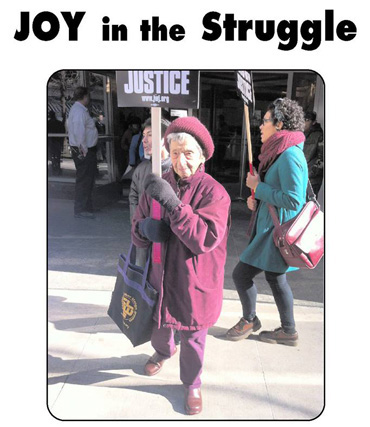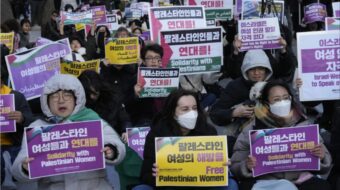
In 1934, New York’s Hunter College tried to increase milk prices in its cafeteria from five to six cents a half pint. A twenty percent increase was as hard to swallow for working-class students then as it is now, so freshman Beatrice Lumpkin led a milk boycott:
“The boycott was a huge success. Students massed around our table. I had to climb on top of a table to be heard. I did not realize that the dean of students had come into the lunchroom… It was too late to be diplomatic; I am afraid that I had already called her a fascist… [The dean] was best known for insisting on proper dress for ‘ladies’. ‘Only Communists or prostitutes would be seen in public without a hat’ was one her pearls of wisdom.”
The author doesn’t mention whether she was wearing a hat at the time, but Lumpkin was already a Communist. She had joined the Young Communist League in high school to study Marxism and work for peace.
Today, at 94, she is still a proud Communist, still a leader in the struggle for justice. She details her 80 years of engagement in the workers’ cause in her new autobiography, “Joy in the Struggle: My Life and Love.”
There is indeed joy in these pages. The author tells of her 60-year marriage to comrade and steelworker leader Frank Lumpkin (the subject of her previous book, “Always Bring a Crowd“). When Lumpkin talks of solidarity with her fellow workers, of seeing in Cuba the first fruits of the Revolution, or of teaching the African roots of mathematics, her book resonates with hope for a better world.
But as the title says, this is a book about struggle. Another, uglier story weaves through Lumpkin’s joy: blacklists and red-baiting, union busting, unemployment, and the vicious racism that she and her husband, like so many others, faced and fought in Chicago in the 1950s and 60s.
This interweaving of anger, sorrow, humor, and joy makes “Joy in the Struggle” a deeply human book about a woman who has devoted her entire life to the fight for equality, democracy, and peace. It is the story of everything that is extraordinary in the trials and triumphs of ordinary working people, told by a great writer, thinker, and fighter of the working class.
More than just one woman’s story, “Joy in the Struggle” is a treasure trove of advice and tactics for others engaged in building workers’ power and solidarity.
In Lumpkin’s vision of the world, nothing falls outside of political work. Injuries and illness show the inequality of access to medical care. Motherhood grounds a discussion of sexism, but also shows the power of solidarity among working women.
Even mandatory hairnets on the job have a lesson (“It was nice to be able to put in curlers and set our hair on the bosses’ time”).
The most valuable lesson, though, has to do with coalition building. Lumpkin returns time and again to the necessity of building coalitions to advance a people’s agenda:
“Bring together everybody who agrees on an issue, even if they disagree on other subjects. The pooled strength of the groups can win on the issue that all the groups support. If we waited until everybody agreed on everything, we could never move forward.”
Beatrice Lumpkin’s extraordinary book, like her extraordinary life, shows the power of people coming together in the fight for a better world. It is a worthy addition to the ranks of great stories of struggle like Elizabeth Gurley Flynn’s Rebel Girl or Ben Davis’ Communist Councilman from Harlem.
Lumpkin’s book is dedicated “to the young people fighting for a world that puts people before profit.” It is a great gift that she has given us, and we are proud to carry on her valiant struggle for a fair, peaceful, and democratic world.
Book Review
Beatrice Lumpkin, Joy in the Struggle: My Life and Love
New York: International Publishers, 2013
Paperback, $12,95












Comments